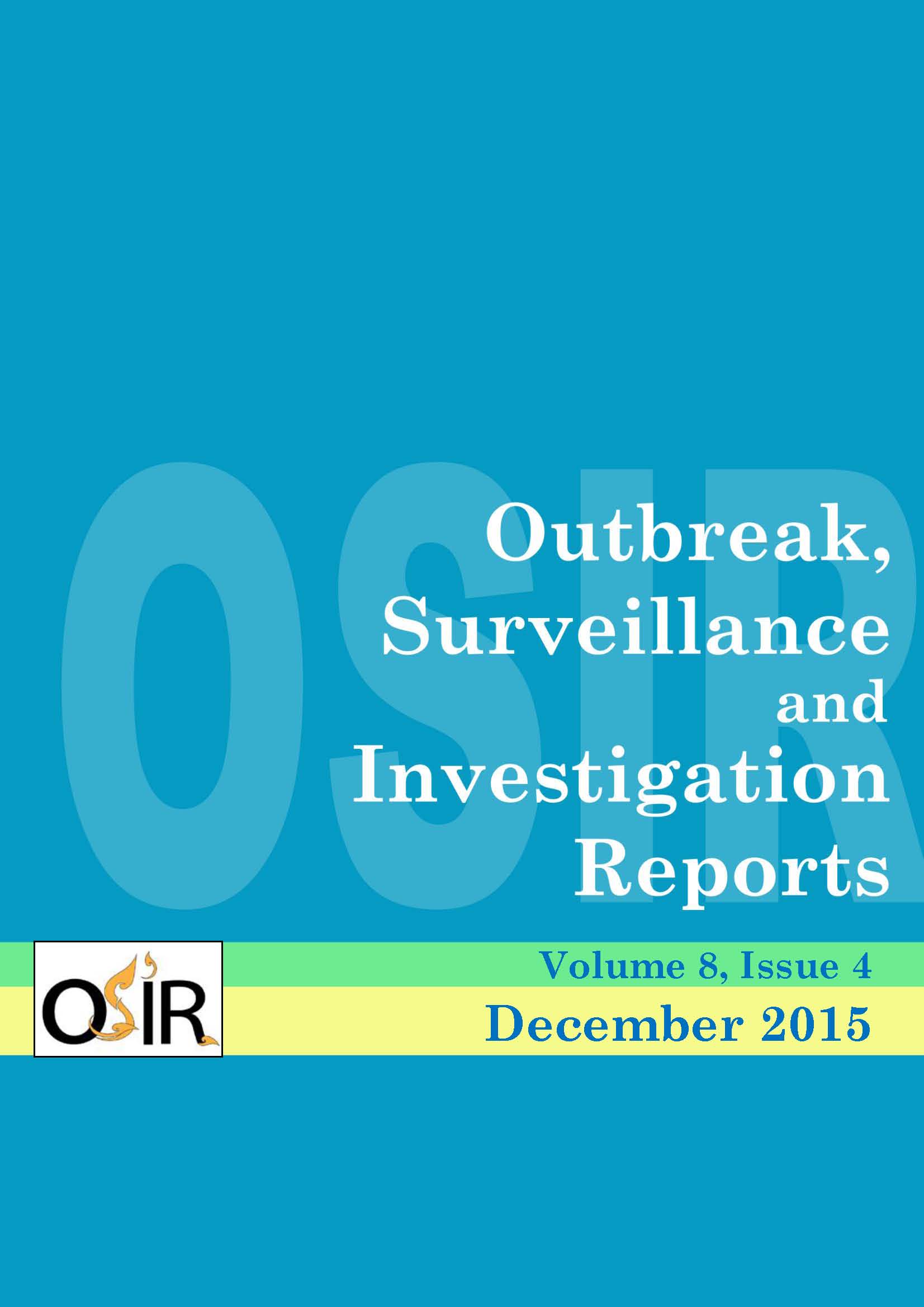A Systematic Evaluation of Dengue Vector Surveillance, Tainan City, Taiwan, 2011-2013
DOI:
https://doi.org/10.59096/osir.v8i4.263229Keywords:
dengue, dengue vector surveillance system, Ae. aegypti, TaiwanAbstract
Outbreaks of dengue fever (DF) are more common in southern than northern Taiwan, with primary transmission through Aedes aegypti mosquito vectors. A dengue vector surveillance system (DVSS) was established in 2005, with the objectives of characterizing dengue vector distribution and evaluating the effectiveness of DF control measures. We evaluated DVSS in Tainan City, a southern city in Taiwan with DF transmission. During 2011-2013, Ae. aegypti predominance was found in 31% of 36 districts. Breteau, container and household indices decreased following district-level vector control campaigns in 2011 and 2013. Levels of data validity and entry error types were more than 90% and less than 10% respectively. Program completeness was found to be low at 17%, primarily influenced by rural neighborhood findings. Completeness of pupal indices was unsatisfactory (12%), limited by time and manpower in collecting pupae. This evaluation of DVSS showed that the system collected complete and valid data necessary for meeting the surveillance objectives. We recommended that completeness of DVSS be further improved in rural districts, pupal index be removed from routine dengue vector surveys, and on-the-job training of survey personnel be established and maintained.
References
Lin CH, Schiøler KL, Jepsen MR, Ho CK, Li SH, Konradsen F. Dengue outbreaks in high-income area, Kaohsiung City, Taiwan, 2003–2009. Emerg Infect Dis. 2012;18:1603-11.
Pinheiro FP, Corber SJ. Global situation of dengue and dengue haemorrhagic fever, and its emergence in the Americas. World Health Stat Q. 1997;50(3-4):161-9.
Murray NEA, Quam MB, Wilder-Smith A. Epidemiology of dengue: past, present and future prospects. Clin Epidemiol. 2013 Aug 20;5:299-309.
Simmons CP, Farrar JJ, Nguyen vV, Wills B. Dengue. N Engl J Med. 2012 Apr 12;366(15):1423-32.
Yang CF, Hou JN, Chen TH, Chen WJ. Discriminable roles of Aedes aegypti and Aedes albopictus in establishment of dengue outbreaks in Taiwan. Acta Trop. 2013 Oct 23;130C:17-23.
Taiwan. Centers for Disease Control. Notifiable infectious disease statistics system. Taiwanese [cited 2015 May 1]. <http://nidss.cdc.gov.tw/default.aspx>
Taiwan. Centers for Disease Control. Guidelines for dengue control. Taipei: Centers for Disease Control; 2015.
World Health Organization. Dengue: guidelines for diagnosis, treatment, prevention and control. New edition. Geneva: World Health Organization; 2009.
World Health Organization. Global strategy for dengue prevention and control 2012-2020. Geneva: World Health Organization; 2012.
German RR, Lee LM, Horan JM, Milstein RL, Pertowski CA, Waller MN. Updated guidelines for evaluating public health surveillance systems: recommendations from the Guidelines Working Group. MMWR Recomm Rep. 2001 Jul 27;50(RR-13):1-35; quiz CE1-7.
World Health Organization. Vector surveillance. 2015 [cited 2015 May 1]. <http://www.who.int/denguecontrol/monitoring/vector_surveillance/en/>
Beatty ME, Stone A, Fitzsimons DW, Hanna JN, Lam SK, Vong S, et al. Best practices in dengue surveillance: a report from the Asia-Pacific and Americas Dengue Prevention Boards. PLoS Negl Trop Dis. 2010 Nov 16;4(11):e890.
Taiwan. Tainan City Government. Dengue fever and other vector control program. Tainan City government; 2011-2013.
Tun-Lin W, Kay BH, Barnes A, Forsyth S. Critical examination of Aedes aegypti indices: correlations with abundance. Am J Trop Med Hyg. 1996 May;54:543-7.
Focks D, Daniels AE, Haile DG, Keesling JE. A simulation model of the epidemiology of urban dengue fever: Literature analysis, model development, preliminary validation, and samples of simulation results. Am J Trop Med Hyg. 1995 Nov;53(5):489-506.
Bowman LR, Runge-Ranzinger S, McCall PJ. Assessing the relationship between vector indices and dengue transmission: a systematic review of the evidence. PLoS Negl Trop Dis. 2014 May 8;8(5):e2848.
Focks DA, Chadee DD. Pupal survey: An epidemiologically significant surveillance methods for Aedes aegypti. An example using data from Trinidad. Am J Trop Med Hyg. 1997 Feb;56(2):159-67.
Das B, Hazra RK. Entomological investigation with special attention to pupal indicators of Aedes vactior during outbreaks of dengue in coastal Odisha, India. Bactor Borne Dis. 2013;50(2):147-50.
Scott TW, Morrison AC. Aedes aegypti density and the risk of dengue virus transmission. In: Takken W, Scott TW, editors. Ecological aspects for application of genetically modified mosquitoes. Dordrecht: Springer Netherlands; 2003. p. 187-206.
Barrera R, Amador M, Diaz A, Smith J, Munoz-Jordan JL, Rosario Y. Unusual productivity of Aedes aegypti in septic tanks and its implications for dengue control. Med Vet Entomol. 2008 Mar;22(1):62-9.
Pilger D, Lenhart A, Manrique-Saide P, Siqueira JB, da Rocha WT, Kroeger A. Is routine dengue vector surveillance in central Brazil able to accurately monitor the Aedes aegypti population? Results from a pupal productivity survey. Trop Med Int Health. 2011 Sep;16(9):1143-50. Epub 2011 Jun 27.
Focks DA, Alexander N. A multi-country study on the methodology for surveys of Aedes aegypti pupal productivity: findings and recommendations. Geneva: World Health Organization; 2006.
Lloyd LS, Winch P, Ortega-Canto J, Kendall C. The design of a community-based health education intervention for the control of Aedes aegypti. Am J Trop Med Hyg. 1994 Apr;50(4):401-11.
Espinoza-Gomez F, Hernandez-Suarez CM, Coll-Cardenas R. Educational campaign versus malathion spraying for the control of Aedes aegypti in Colima, Mexico. J Epidemiol Community Health. 2002 Feb;56(2):148-152.
Downloads
Published
How to Cite
Issue
Section
License
Copyright (c) 2023 Outbreak, Surveillance, Investigation & Response (OSIR) Journal

This work is licensed under a Creative Commons Attribution-NonCommercial-NoDerivatives 4.0 International License.









